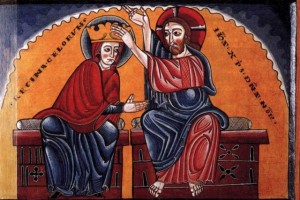Introduction
In my last post I addressed Karl Barth’s use of the term “Seinsweise” or modes of being. In this post I will look at the other two aspects of Barth’s doctrine of the trinity; his use of logos asarkos to distinguish the second person of the Trinity, and his concept of God being in threefold repetition.
Logos Asarkos
Now that the problem of Barth’s use of the term modes of being has been addressed and defined it is now our task to see if Barth does make proper orthodox distinctions between each mode, specifically the Father from the Son. One of the ways that Barth makes this distinction is in speaking of Christ as logos asarkos. It is in this concept that he “clearly distinguishes the Father from the Son.” It is through the Logos asarkos that Barth’s distinction between the second mode of the Trinity and the first and third is made. It is foundational for understanding Barth’s “doctrine of the Trinity and Christology that recognizes and maintains God’s freedom.”
The term logos asarkos refers to Christ without the flesh. The second mode of the trinity was logos asarkos prior to the incarnation. He did not bring a body and soul with him when he entered into history. “There could be no denying the reality of the logos asarkos prior to the incarnation.”
What logos asarkos does for Barth is show that God acting for us could have existed in seclusion from his creation but freely chose to be engaged with it. Barth affirms the logos asarkos and also denies it based on what he wants to communicate about Christ. In his affirmations and denials one can see that he is making distinctions between Christ and the other persons of the Trinity. Barth denies the logos asarkos if it means that Christ is a “formless Christ” or a “Christ principle” that did not exist as the Word prior to creation. He also denies logos asarkos in terms of revelation “if it meant a retreat to an idea of God behind the God revealed in Christ.” In Barth’s specific denials of the logos asarkos there is a clear desire to show that Christ is different from the Father and that He cannot be clasped into a formless part of the Godhead. “The Word is what He is even before and apart from His being flesh.”
Barth affirms that logos asarkos is of the utmost importance in the doctrine of the Trinity because it allows Jesus to have a distinctive function as incarnate God. The logos asarkos helps God maintain freedom and allows Barth to recognize the Trinity’s existence by itself “and that our Trinitarian thinking can never substitute historical relations for the relations of the Father, Son, and Holy Spirit that are decisive for the events that take place within the economy.”
Along these same lines, in IV.2 Barth makes a distinction between the Son of God and the Son of Man. The “eternal Word” is the same as the “Son of God,” meaning that Barth attributes the title of eternal Word to the second person of the Trinity, which is distinct from the Father. He also writes that the Son of Man is the same as “the person of Jesus of Nazareth,” showing that the term Son of Man is distinguished for Jesus incarnated while Son of God refers to the Word without flesh, or logos asarkos. So when Barth writes that “it is in His power that the will of the Father is fulfilled in the fact that the Son of God assumes human essence and therefore becomes the Son of Man, exalting human essence to fellowship with God,” there is clearly a Son of God that exists apart from the Father before the incarnation that becomes the Son of Man. Barth then continues on in this passage to show a distinction between the Holy Spirit and Jesus Christ as the Spirit bears witness to the work of the Son. Barth’s distinction can be shown clearly in the below diagram:
Father Son of God/Eternal Word Holy Spirit
⇓
Son of Man/Jesus of Nazareth
Above the line is the Godhead existing in perfect unity, but separated in three modes of being. The Son of God is distinguished from the other two modes. In opposition to modalism, the second mode has a distinct place amongst the Godhead, which becomes Jesus of Nazareth.
Repetitions
Another criticism of Barth is that he sees the “Father, Son and Spirit” as “one God in threefold repetition,” and that “He is the one God in each repetition.” This repetition is what he terms an “eternal repetition” that exists from all eternity; that is, it implies no alteration or change in the Godhead. This repetition of the Trinity is the foundation to Barth’s doctrine of revelation. God Himself is “unimpaired unity” yet also “unimpaired distinction” as “Revealer, Revelation, and Revealedness.”
The Father reveals Himself to be creator and “Lord of our existence.” As we have seen, He is the Father not because of His relation to His creation, but as the Father of the Son. The Son reveals Himself to be reconciler and unites humanity with the Father through overcoming sin and uniting us with God. Barth writes:
If he can be the humiliated and lowly and obedient One only in a mode of appearance and not in His proper being, what is the value of the true deity of Christ, what is value for us? It is as the humiliated and lowly and obedient One that He is the reconciler. But can He reconcile if He has no proper being as the Reconciler, but only that of the form of appearance of the one true God, who has no part in the atonement?
Christ cannot reconcile if He does not have proper being as the reconciler. Barth shows here that if modalism were true there would be no need for Christ to be full deity. Barth also explicitly writes “the second ‘person’ of the Godhead in Himself and as such is not God the Reconciler.”
We can see that there is a kind of subordination in the Trinity. Reconciliation comes after the act of creation. The Son comes after the Father not the other way around, which is a distinction not of essence, but of mode. The Holy Spirit is not the same as the son because “the spirit guarantees man’s participation in revelation.” Barth also “staunchly defends the filioque.”
Though it may seem that Barth, by using this idea of repetition, is destroying the distinctions of the modes of the trinity, he is actually trying to protect against “the wrong kinds of distinctions, distinctions that imperil God’s unity.”
Conclusion
Barth does use the controversial title modes of being rather than the traditional term persons. He does this in order to preserve the unity of the God-head and protect from tritheism. Barth, throughout the Dogmatics both implicitly and explicitly shows that the mode of the Father is not the same as the mode of the Son, or the mode of the Spirit. His use of this term should not be related to the historical connotation with modalism.
We have also seen that Barth certainly sees the second person of the Trinity as distinct from the Father as he affirms and denies certain aspects of the idea of logos asarkos. In Barth’s denials of the logos asarkos there can be seen his desire to show that Christ is different from the Father. In His affirmations Barth shows Jesus’ distinctive function as incarnate God. It can also be seen in Barth’s use of the terms Son of God and Son of Man that there is a place in the Godhead specifically designated for the eternal Word that is different from the Father.
Barth is also not promoting modalism in his use of repetitions in the Godhead. He is trying to protect against wrong kinds of distinctions, distinctions within God that would imperil his unity. The Father reveals himself to be creator, not because of his relation to his creation, but as the Father to the Son. The Son reveals himself as reconciler, not creator, and unites humanity with the Father through overcoming sin. Reconciliation comes after the act of creation, thus the Son comes after the Father, which is not a distinction of essence, but of mode.
It is clear that any attempt to understand Barth’s doctrine of the Trinity needs to be understood in light of the entire Dogmatics. To limit Barth’s discussion of this topic to just I/1 leaves out significant and important sections of his theology.
Nathaniel Warne is currently a Ph.D. candidate at Durham University U.K. where he is studying theological ethics and political philosophy. He is currently studying under Christopher J. Insole and Alec Ryrie. Nathaniel received a B.S. in Art (Painting and drawing) and minored in Biblical Studies at Biola University. After receiving his undergraduate degree, Nathaniel spent three years as a professional session drummer. He then received an M.A. from Talbot School of Theology in moral and historical theology. He wrote his masters thesis on 16th century Geneva and its political influence of John Locke. Nathaniel was also a minister at Grace Evangelical Free Church, La Mirada before moving to Durham. He has been married to his beautiful wife Charissa for five years. Nathaniel’s primary academic interests: theological ethics, political philosophy, intersection of metaphysics with ethics, especially with regard to haecceity and modality, Puritan’s doctrine of calling, theology of work, history of natural law, Aristotle, and Søren Kierkegaard. He also enjoys reading: John Locke, Karl Barth, Philosophy of Aesthetics, and Literature of all sorts. Some hobbies of Nathaniel’s are playing and listening to music (jazz, folk, rock, hip-hop), cooking, foreign and domestic beers, and watching Fringe, 30 Rock, Big Bang Theory, and Cosby Show with his wife.
Nathaniel can be reached at: n.a.warne at durham.ac.uk





Leave a Reply
Your email is safe with us.